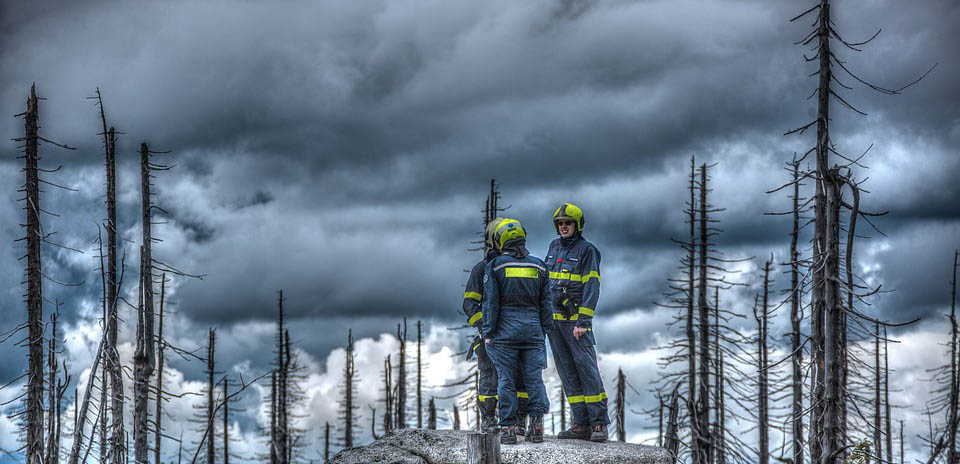Pyro-cumulonimbus plumes
Contents |
[edit] Introduction
Pyro-cumulonimbus plumes, often called pyroCb for short or more formally, cumulonimbus flammagenitus clouds (CbFg), are clouds generated by extreme heat released at the surface of the earth, such as from a volcanic eruption, or a wild fire, in some cases enhanced by localised industrial combustion emissions. They can have a distinctive grey colour because smoke particles, which can lead to thunderstorms as water condenses on their surface, and they can rise up high into the upper troposphere or lower stratosphere.
[edit] Examples
One of the earliest photographs of a major pyroCb occurred in Hiroshima, some time after the atomic bomb and its infamous atomic cloud in 1945. It was caused by the devastating ground level firestorm that jointly killed over 30% of the population of the city.
In 1991, sometime after the eruption of Mount Pinatubo in the Philippines, volcanic thunderstorms formed near its summit, but also in areas away from the summit, near smaller localised heat sources. These clouds produced rain or mud fall as it contained ashes from the initial eruption.
In 2003, 2009 and 2019 extreme summer wildfires in Australia created what were reported as fire tornadoes and significant lightening clouds throughout the period when the fires burnt. Similar incidences occurred in the US and Canada and elsewhere in 2020-2022, so much so that pyroCb's are often now referred to more commonly as fireclouds.
[edit] Comment
In 2021 a a meteorologist at the US Naval Research Laboratory noted about fireclouds that:
“You can think of them as like giant chimneys, funneling smoke that's being released by the fire up into a thunderstorm... this extremely dirty thunderstorm, with all these smoke particles for water to condense on.”.. though, the resulting water droplets don’t tend to get large enough to fall as rain. “But it is a cloud that can produce a lot of lightning,” These clouds can then advance across the landscape, sparking new wildfires as they go. So not only can the blaze propagate itself by flinging embers ahead of the main fire line, it can also produce so much hot, rising smoke that it in essence recruits the atmosphere to light more fires.
[edit] Climate change
The Fourth National Climate Assessment (NCA4), Climate Science Special Report Volume I noted that climate change enhances the drying of organic matter in forests (the material that burns and spreads wildfire), and has doubled the number of large fires between 1984 and 2015 in the western United States. The top 10 years with the largest annual acreage burned all occurred since 2004, a period which coincides with many of the warmest years on record across the US and worldwide.
Severe drought, heat and low humidity become more common and extreme as the climate warms, these hot and dry conditions are often referred to as fire weather. Scientists can measure changes in fire weather (temperature, humidity, rainfall and wind) to rate the level of danger of a wildfire striking.
The Fire Weather Index (FWI) is a meteorologically based index used worldwide to estimate fire danger. It consists of different components that account for the effects of fuel moisture and wind on fire behaviour and spread. The higher the FWI, the more favourable the meteorological conditions are for triggering a wildfire.
[edit] Related articles on Designing Buildings
- Adaptation.
- Climate.
- Climate change.
- Disaster.
- Drought.
- Exceptionally adverse weather.
- Extreme weather.
- Fire Weather.
- Flood.
- Global warming.
- Weather.
[edit] External references
Featured articles and news
RTPI leader to become new CIOB Chief Executive Officer
Dr Victoria Hills MRTPI, FICE to take over after Caroline Gumble’s departure.
Social and affordable housing, a long term plan for delivery
The “Delivering a Decade of Renewal for Social and Affordable Housing” strategy sets out future path.
A change to adoptive architecture
Effects of global weather warming on architectural detailing, material choice and human interaction.
The proposed publicly owned and backed subsidiary of Homes England, to facilitate new homes.
How big is the problem and what can we do to mitigate the effects?
Overheating guidance and tools for building designers
A number of cool guides to help with the heat.
The UK's Modern Industrial Strategy: A 10 year plan
Previous consultation criticism, current key elements and general support with some persisting reservations.
Building Safety Regulator reforms
New roles, new staff and a new fast track service pave the way for a single construction regulator.
Architectural Technologist CPDs and Communications
CIAT CPD… and how you can do it!
Cooling centres and cool spaces
Managing extreme heat in cities by directing the public to places for heat stress relief and water sources.
Winter gardens: A brief history and warm variations
Extending the season with glass in different forms and terms.
Restoring Great Yarmouth's Winter Gardens
Transforming one of the least sustainable constructions imaginable.
Construction Skills Mission Board launch sector drive
Newly formed government and industry collaboration set strategy for recruiting an additional 100,000 construction workers a year.
New Architects Code comes into effect in September 2025
ARB Architects Code of Conduct and Practice available with ongoing consultation regarding guidance.
Welsh Skills Body (Medr) launches ambitious plan
The new skills body brings together funding and regulation of tertiary education and research for the devolved nation.
Paul Gandy FCIOB announced as next CIOB President
Former Tilbury Douglas CEO takes helm.
UK Infrastructure: A 10 Year Strategy. In brief with reactions
With the National Infrastructure and Service Transformation Authority (NISTA).























